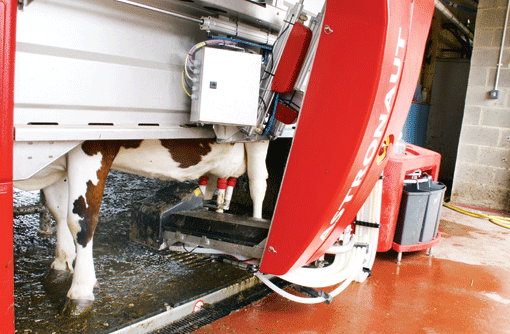Robotic milking puts the cow in control

Robotic milking is becoming a more common sight on today’s dairy farms, with many producers reporting improvements in overall health and performance as a result writes David McCrae of Capontree Veterinary Centre, Cumbria.
One of them main advantages of a robotic system is that the cow has considerable control over both the timing and frequency of milking.
The system aids earlier identification of potential problems and can provide more time for the stockman to carry out other work. The disadvantage at the moment is reliability of the equipment.
Twelve months ago father and son Frank and Richard Beaty from Laversdale, north Cumbria, purchased a milking robot, altered cubicle sheds and put in a shedding gate to control which cows had access to pasture depending on when they were last milked.
Prior to changes when they milked in their old converted byre parlour system, somatic cell counts were averaging 250 000 cells/ml, however this has now dropped to 150-170,000 cells/ml. The reduction in cell count can be attributed to several factors:
1) Teat preparation is the same every time, quarters are individually milked so no quarter is over milked.
2) Teats are treated automatically post-milking ensuring full cover of the teat with dip.
3) Clusters are sterilised with a steam jet killing 99% of bacteria which has reduced the spread of contagious bacteria.
The robots use milk conductivity which flags up those cows which are possibly starting with mastitis. Early detection and aggressive therapy has reduced the number of cows requiring re-treatments.
Richard Beaty commented that conductivity is a good guide if the cow is starting with mastitis, but he will look at the robots computer records for that cow for the previous 24 hours to see if she has dropped in milk production, or visits to the robot. He will then strip the udder. If there are no obvious signs of mastitis he may use some uddermint and not treat at all, or if factors dictate he will treat aggressively.
With robotic milking the farm is milking fewer cows, but getting greater yield a cow with stock now averaging 30 litres of milk a cow a day during the summer. This is a great improvement from last year when they were struggling to get 25 litres a cow a day. The cows decide when they want to be milked with milking averaging three milkings a day in the winter and 2.6 milkings a day in the summer.
During the summer the Beatys also cut fresh grass each day and bring it in for the cows which also have access to two grazing paddocks. The robots are set so the maximum number of milkings each cow would have is four. On one day a cow visited the robot 14 times, so obviously it’s a pleasurable experience.
I asked if the knowledge of individual cows was less now they don’t have that twice daily interaction. Richard Beaty said that his knowledge was actually better: he knows which cows are performing best and worst, which cows are losing weight (due to the weigh scales built into the robot), he has a much better knowledge of the fertility status and which cows are cycling and those that are not. Plus robotic milking has freed up 3-4 hours a day allowing more time for animal husbandry.
Having a better control of cow condition and feed intakes has led to an improvement in the fertility of the cows. The cows are fitted with rumination collars which are a great aid for heat detection.
The Beatys struggled to find any negatives around installing the robots, other than the occasional reliability issues, which involves phone calls from the robot in the middle of the night.
One year down the line and they have a herd of contented, less stressed cows that are in control of their own day. Mrs Beaty added she also has a less grumpy husband.
 XLVets is a group of farm animal-committed vet practices that work together, alongside commercial research and manufacturing companies. They aim to share best practice on advice and disease-prevention initiatives.
XLVets is a group of farm animal-committed vet practices that work together, alongside commercial research and manufacturing companies. They aim to share best practice on advice and disease-prevention initiatives.
